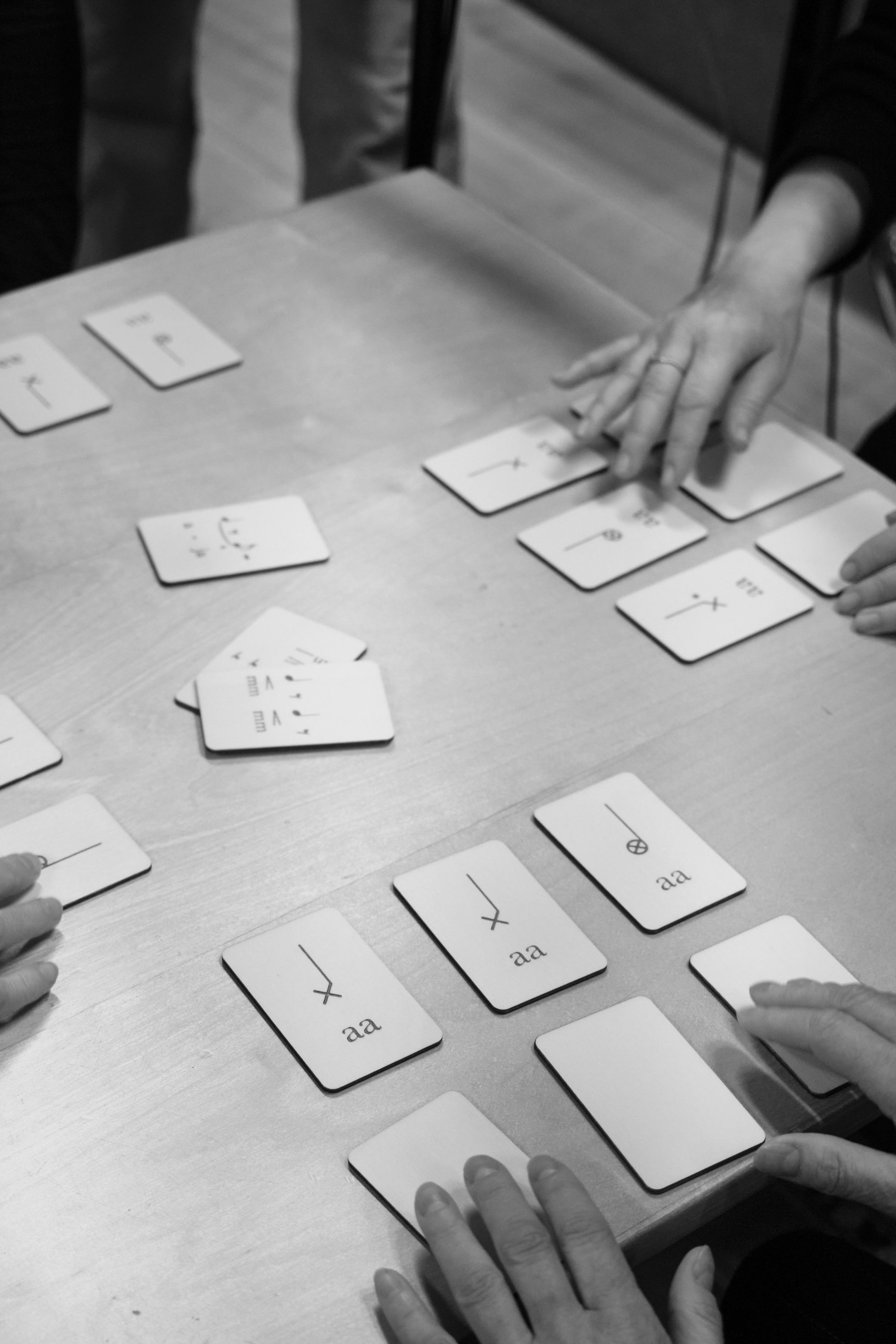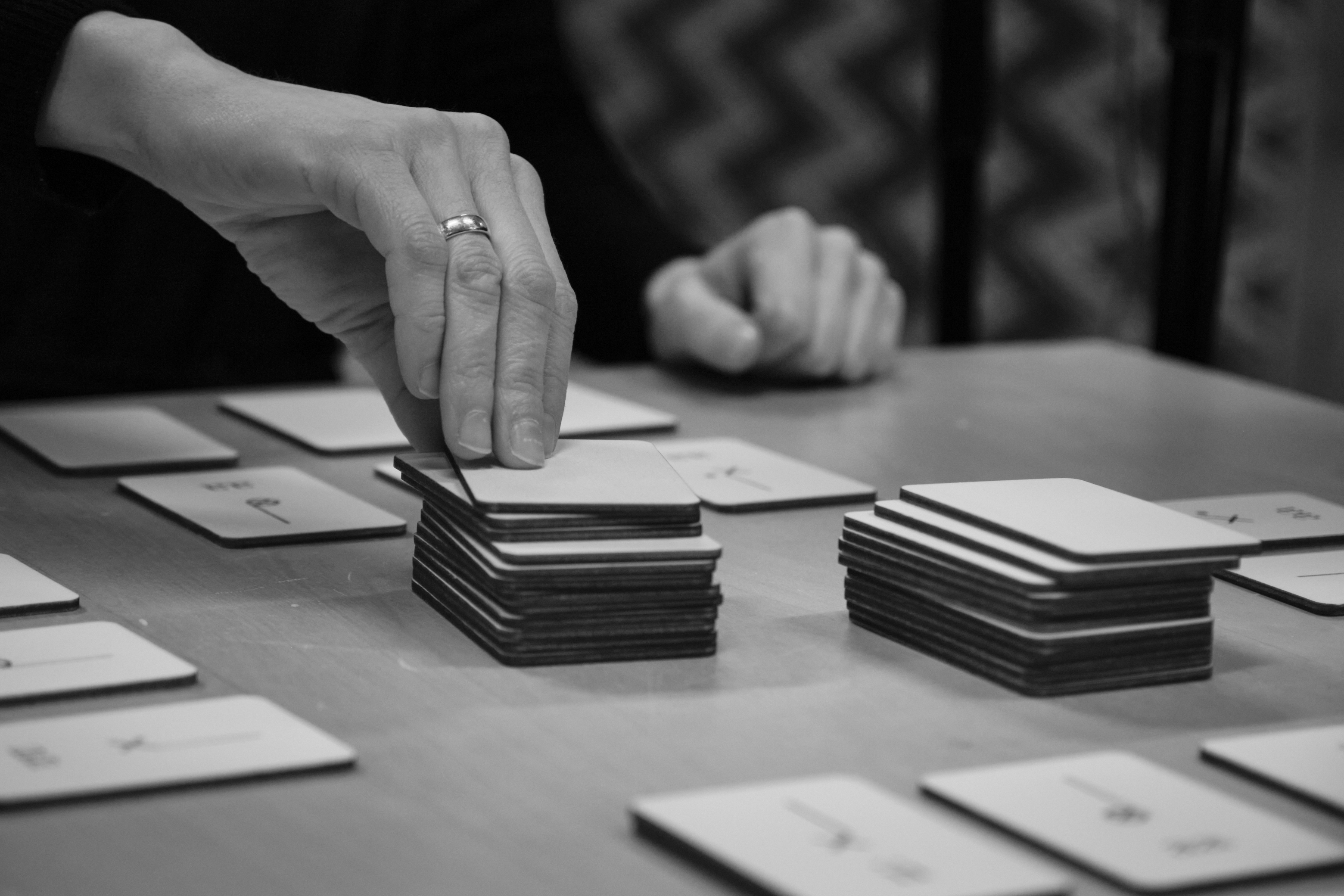
Game Mechanics for Voices: ‘Origin’
2019
2019
Card game for four vocalists
‘Origin’ is a turn-based evolution of language! The movement emerges as a symbolic representation of a starting point, where the vocalists draw cards of vowels, creating linguistic patterns that mimic infant sounds, proto-world languages and early stages of communication.
Each vocalist starts by choosing three vowel cards and placing them in random order in front of them. The rest of the vowel cards are placed in a stack in the middle of the table. In addition before starting the piece, each vocalist must draw three “melodic phrase” cards and place them face down below their vowel cards.
The piece begins with a vocalist reciting the sounds from its three cards, followed slowly by the rest of the vocalists - one at a time. The reciting has to be done in a spoken manner, looping the sounds rhytmically (at approx. 100-110 bpm). Each card is indicated by a vowel and a rhythmic length. These indicate the rhythmic pattern and sounds that the cards produce.
![]()
The vocalists take turns clockwise to draw a new vowel card from the stack and place it on top of the cards in their deck, left to right. Each time a new card is placed on top of another, the vocalists are required to speak/sing out the new formation of sounds of their current deck. This must be done from left to right, and looping these until next round.
Each vocalist must continue their current rhythmic pattern of sounds until all of the other vocalists have drawn a new card and begun their new rhythmic pattern. There must be space between draws for each vocalist to settle into their current pattern.
When all the vowel cards from the stack on table are gone, the vocalists begin to move into the next part of the piece. Here, vocalists take turns turning over a “melodic phrase” card, and placing it on top of their vowel cards, from left to right. In this way, the phrases transition into the rhythmic pattern.
![]()
When all the phrase cards have been turned over, the vocalists stop singing their last phrase one at a time, and thus the piece ends.
‘Origin’ is a turn-based evolution of language! The movement emerges as a symbolic representation of a starting point, where the vocalists draw cards of vowels, creating linguistic patterns that mimic infant sounds, proto-world languages and early stages of communication.
Each vocalist starts by choosing three vowel cards and placing them in random order in front of them. The rest of the vowel cards are placed in a stack in the middle of the table. In addition before starting the piece, each vocalist must draw three “melodic phrase” cards and place them face down below their vowel cards.
The piece begins with a vocalist reciting the sounds from its three cards, followed slowly by the rest of the vocalists - one at a time. The reciting has to be done in a spoken manner, looping the sounds rhytmically (at approx. 100-110 bpm). Each card is indicated by a vowel and a rhythmic length. These indicate the rhythmic pattern and sounds that the cards produce.

The vocalists take turns clockwise to draw a new vowel card from the stack and place it on top of the cards in their deck, left to right. Each time a new card is placed on top of another, the vocalists are required to speak/sing out the new formation of sounds of their current deck. This must be done from left to right, and looping these until next round.
Each vocalist must continue their current rhythmic pattern of sounds until all of the other vocalists have drawn a new card and begun their new rhythmic pattern. There must be space between draws for each vocalist to settle into their current pattern.
When all the vowel cards from the stack on table are gone, the vocalists begin to move into the next part of the piece. Here, vocalists take turns turning over a “melodic phrase” card, and placing it on top of their vowel cards, from left to right. In this way, the phrases transition into the rhythmic pattern.

When all the phrase cards have been turned over, the vocalists stop singing their last phrase one at a time, and thus the piece ends.



